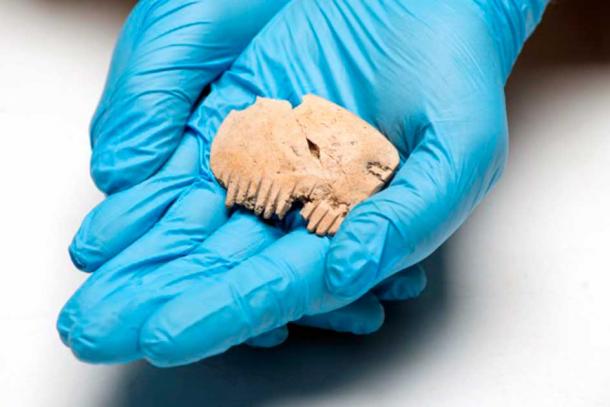While sorting through some 280,000 artifacts excavated from land reserved for a highway construction project running from Cambridge to the village of Huntingdon in eastern England, archaeologists affiliated with the Museum of London Archaeology (MOLA) discovered a miniature comb that was incredibly ancient and also made from a most unusual material. Now dated to Britain’s Iron Age (750 BC to 43 AD), the two-inch (five-centimeter) comb was carved out of a fragment of a human skull, which may have belonged to a respected elder or perhaps a dead ancestor of the comb’s owner.
It looks Like a Comb, but Was it?
This unusual and intriguing item was originally excavated at Bar Hill, a village in the county of Cambridgeshire in east-central England located just four miles (6.5 kilometers) outside of Cambridge. It was removed as part of a 2016-2018 excavation project, which was designed to rescue historical artifacts and ruins that would have been threatened by the digging and blasting associated with the highway project.
The so-called Bar Hill Comb features nearly a dozen carved teeth. While it is certainly shaped like a comb, there is no evidence of any wear on its surface, suggesting it wasn’t used much if at all as a hairstyling tool. There is a small hole drilled into the comb’s upper part, which likely means it was worn on a string hung around someone’s neck.
After closer examination, the MOLA researchers believe this particular comb was made sometime between 400 and 100 BC. An Iron Age village existed at the Bar Hill site during this time period, and the researchers assume the comb was carved by a craftsperson from this settlement.

The 2000–2500-year-old object appears to be a comb from the Iron Age. ( MOLA)
Is it a Comb, or a Spiritual Relic?
The human skull comb may have been a decorative or ceremonial object, the MOLA analysts say. This would explain why it has a hole at the top, indicating it was the centerpiece of a necklace or amulet.
“The Bar Hill Comb may have been a highly symbolic and powerful object for members of the local community,” excavation leader and Museum of London Archaeology prehistory specialist Michael Marshall stated in a MOLA press release about this surprising discovery. “It is possible it was carved from the skull of an important member of Iron Age society, whose presence was in some way preserved and commemorated through their bones.”
Marshall suggested that the carvings on the ancient object’s surface may not have been comb teeth at all. He thinks they may represent the sutures that join sections of the human skull into a unified whole.
“These carved teeth and lines would have emphasized the Bar Hill Comb’s origin, at least amongst communities familiar with skeletal remains—as many in the Iron Age would have been,” Marshall theorized. “Rather than being an anonymous piece of bone, its symbolism and significance would therefore have been immediately apparent to anyone who encountered it.”

A hole cut in the object suggests it was used as an amulet, rather than a comb. ( MOLA)
For the purposes of comparison, Marshall mentioned two other similar objects made from human skull fragments that were unearthed in Cambridgeshire and have been dated to the Iron Age. The first of these, found at Earith in the 1970s, featured a set of carved teeth, just like the Bar Hill Comb. The second, which was recovered at Harston Mill in the early 2000s, was comb-shaped and had incised lines, but no teeth. In each case, the features seemed to mimic those of the human skull.
“It is possible this fascinating find represents a tradition carried out by Iron Age communities living solely in this area of Cambridgeshire,” Marshall said, linking the Bar Hill Comb to the other Cambridgeshire finds. “To be able to see such hyper-local influences in groups of people living over 2,000 years ago is truly astonishing.”
There is no way to tell for sure if Bar Hill Comb was actually used in religious rituals, or as a talisman meant to ward off evil forces or bring the blessings of the gods. But its apparent use as an amulet shows it is something other than a simple hairstyling item.
Building the Archaeology Superhighway
Pieces of human skull with holes drilled in them have been found at other archaeological sites in Britain. It is believed these objects were worn as amulets, suggesting this practice was rather widespread in the prehistoric past.
Additionally, tools made from human leg and arm bones have been found at various digs, showing that Iron Age residents of Britain were not the least bit reluctant to make use of human remains. In some instances skulls were removed from bodies after death and put on display, in a form of ancestor worship that was apparently common in Iron Age Europe.
As for the Bar Hill Comb, it will now be kept at the Cambridgeshire Archaeology Archive, which is the main repository for archaeological finds from eastern England. In the meantime the MOLA experts will continue to search through the 280,000 artifacts they’ve collected during excavations connected to the National Highways A14 Cambridge to Huntingdon Improvement Scheme , looking for more hidden treasures
Speaking about the incredibly fertile 2016-2018 digs, Dr. Steve Sherlock, the Archaeology leader of the A14 project, expressed his excitement about what has been recovered and uncovered so far.
“This is a further example of the spectacular results from the excavations for the A14 improvements, adding detail and insight into our understanding of the human activity across Cambridgeshire and beyond,” he exclaimed, in a specific reference to the Bar Hill Comb.
This unique item was preserved for more than 2,000 years in the earth beneath what will soon be a major thoroughfare, and would still be there if this new mega-highway had not been built. It is a testament to the importance of the highway archaeology project, which can be classified as a true historical rescue mission.
source: https://www.ancient-origins.net







